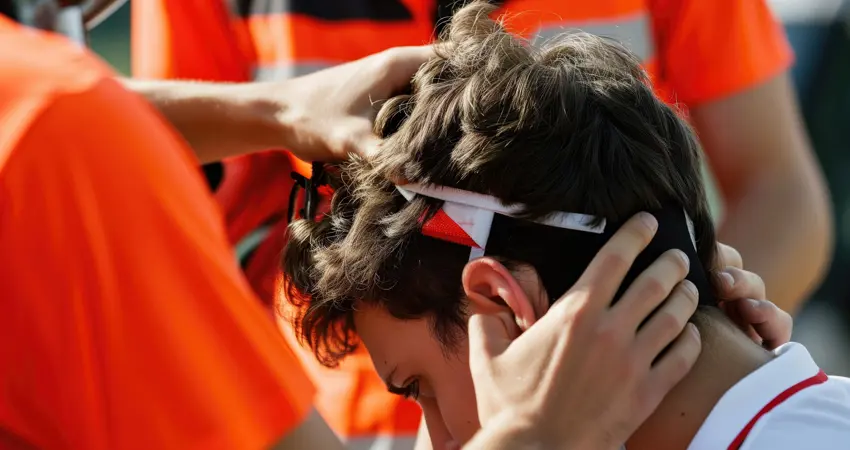13 Feb 2025
Review highlights need for improvements to sport-related brain injury monitoring tools
A comprehensive systematic review of current tools for on-the-day assessment and diagnosis of mild traumatic brain injury in sport, by researchers at the Podium Institute for Sports Medicine & Technology, has just been published in the British Medical Journal Open Sports and Exercise Medicine

Young player receives medical attention for head injury.
A comprehensive systematic review by researchers at the Podium Institute for Sports Medicine & Technology, University of Oxford, comparing the current tools used for on-the-day assessment and diagnosis of mild traumatic brain injury in sport, has been published in the British Medical Journal Open Sports and Exercise Medicine.
The primary goal of this review is to evaluate the performance of these monitoring tools used within 24 hours of injury, and to determine whether the current techniques are fit for purpose, provide recommendations for their improvement, and highlight areas requiring further development.
The review, entitled Performance of current tools used for on-the-day assessment and diagnosis of mild traumatic brain injury in sport: A systematic Review, marks a significant step in the development of future best practices for evaluating head impacts in athletes, particularly highlighting the need for a ‘gold standard’ for the assessment and diagnosis of this widespread type of injury in athletes.
Mild Traumatic Brain Injury (mTBI), often referred to as concussion, is a closed head injury, which results from a direct blow to the head or rapid acceleration/deceleration, potentially causing temporary loss of consciousness, confusion, disorientation, and amnesia, among other short- and long-term symptoms1. In the UK, mTBI is a significant health concern. Each year, over 1 million individuals attend emergency departments in England and Wales due to recent head injuries. Of these, approximately 68% are classified as mild TBIs.2
Professor Antoine Jérusalem MSc PhD, corresponding author and Podium Institute Affiliated Faculty, says of the review: “Paradoxically, the more we know about traumatic brain injury, the clearer it is that one unique definition doesn’t apply for the wide range of symptoms, injuries, and time scales involved. To this end, many teams and federations have embraced a variety of metrics or tools to assess the risk of injury on-the-fly or immediately after a given head impact. In this systematic review, we summarise the existing monitoring tools used for the on-the-day diagnosis of sport-related mTBI. This effort poses the basis for the establishment of the best possible metrics and aims to identify where more efforts could be done.”
The reviewers, who evaluated 2,534 unique records and analysed over 50 reports, uncovered several interesting findings. Notably, 90% of reports lacked precise documentation of the time between the measurement and the injury. This is a significant limitation, as sport-related brain injuries and their symptoms evolve over time, making accurate and timely reporting of head impacts essential. The performance of assessment methods varied considerably, with accuracy-related metrics being the most commonly utilised. While multi-modal assessments are considered optimal, they can be resource-intensive and do not necessarily enhance our understanding of sports-related mTBI. Additionally, female athletes remain generally underrepresented in the available literature.
Phoebe Haste MEng, Podium Institute doctoral student and main author of the systematic review comments, “The variety of methods present in this work show the exciting yet fractured field of assessing sports related mTBI. Clearly, there has been a significant effort, across borders and sporting disciplines, to examine the assessment methods for sports-related mTBI. However, just as bruises change colour, brain injuries can change their presentation over time. I was surprised to discover that the majority of studies reviewed did not consider the evolution of the presentation of brain injuries over the short period of time between injury and assessment. I hope that this review can encourage the recording of this time period in future.”
Phoebe’s interest in this field comes from personal experience. While playing rugby union she sustained a concussion which led to post-concussion syndrome due to her continuing to play on when concussed. “After completing my MEng at the University of Oxford, I was excited to realise I could contribute to the understanding and prevention of sports-related mTBI through further research. I am now attempting to use machine learning to predict concussion from on-the-day assessments of athletes.”
Professor Constantin Coussios OBE FREng FMedSci, Director of the Podium Institute, commented: “As an independent research institute entirely dedicated to the development of new technologies for the safety and well-being of athletes in the community, youth and professional sport, we are currently leading several multi-modal studies aimed at addressing the paucity of data directly relating exposure to head impacts during play to short-, medium- and long-term neuroimaging, neurological and psychological outcomes for individual athletes. We are optimistic that this research will help us address the findings of this systematic review and enable us to develop, validate and deploy scalable, cost-effective and continuously improving tools that can prevent sport injury and its longer-term consequences.”
1 https://www.sciencedirect.com/science/article/pii/S0028377020300606?via%3Dihub




